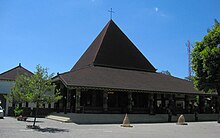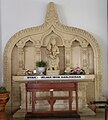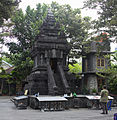
The Special Region of Yogyakarta is a province-level special region of Indonesia in southern Java. It is a semi-enclave that is surrounded by on the landward side by Central Java Province to the west, north, and east, but has a long coastline on the Indian Ocean to the south.

The Catholic Church in Indonesia is part of the worldwide Catholic Church, under the spiritual leadership of the pope in Rome. Catholicism is one of the six approved religions in Indonesia, the others being Islam, Protestantism, Hinduism, Buddhism, and Confucianism. According to official figures, Catholics made up 3.12 percent of the population in 2018. The number of Catholics is, therefore, more than 8.3 million. Indonesia is primarily Muslim, but Catholicism is the dominant faith in certain areas of the country.

The Karo people are a people of the Tanah Karo in North Sumatra, Indonesia. The Karo lands consist of Karo Regency, plus neighboring areas in East Aceh Regency, Langkat Regency, Dairi Regency, Simalungun Regency, and Deli Serdang Regency. In addition, the cities of Binjai and Medan, both bordered by Deli Serdang Regency, contain significant Karo populations, particularly in the Padang Bulan area of Medan. The town of Sibolangit, Deli Serdang Regency in the foothills of the road from Medan to Berastagi is also a significant Karo town.

Several different religions are practised in Indonesia. Indonesia is officially a presidential republic and a unitary state without an established state religion. The first principle of Indonesia's philosophical foundation, Pancasila, requires its citizens to state the belief in "the one and almighty God". Although, as explained by the Constitutional Court, this first sila of Pancasila is an explicit recognition of divine substances and meant as a principle on how to live together in a religiously diverse society. Blasphemy is a punishable offence and the Indonesian government has a discriminatory attitude towards its numerous tribal religions, atheist and agnostic citizens. In addition, the Aceh province officially applies Sharia law and is notorious for its discriminatory practices towards religious and sexual minorities.
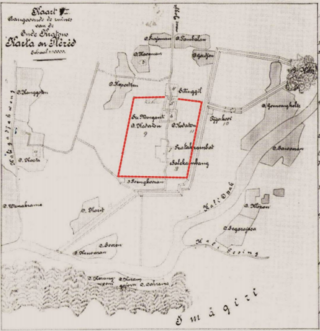
Plered was the location of the palace of Amangkurat I of Mataram (1645–1677). Amangkurat moved the capital there from the nearby Karta in 1647. During the Trunajaya rebellion, the capital was occupied and sacked by the rebels, and Amangkurat died during the retreat from the capital. His son and successor Amangkurat II later moved the capital to Kartasura. It was twice occupied by Diponegoro, during the Java War (1825–1830) between his forces and the Dutch. The Dutch assaulted the walled complex in June 1826, which was Diponegoro's first major defeat in the war.

Christianity is Indonesia's second-largest religion, after Islam. Indonesia also has the second-largest Christian population in Southeast Asia after the Philippines, the largest Protestant population in Southeast Asia, and the third-largest Christian population in Asia after the Philippines and China. Indonesia also has the second-largest Christian population in the Muslim world, after Nigeria, followed by Egypt. Indonesia's 29.4 million Christians constituted 10.47% of the country's population in 2023, with 7.41% Protestant and 3.06% Catholic. Some provinces in Indonesia are majority Christian. In Indonesia, the word Kristen refers to Protestantism, while Catholicism is referred to as Katolik. In the 21st century the rate of growth and spread of Christianity has increased, especially among the Chinese minority.

Protestantism is one of the six approved religions in Indonesia, the others being Islam, Roman Catholicism, Hinduism, Buddhism, and Confucianism. It constitutes the bulk of Christianity in Indonesia, which is the second largest religion in the country after Islam.

Jakarta Cathedral is a Roman Catholic cathedral in Jakarta, Indonesia, which is also the seat of the Roman Catholic archbishop of Jakarta, currently Archbishop Ignatius Suharyo Hardjoatmodjo. Its official name is Gereja Santa Maria Diangkat ke Surga, derived from the original name in Dutch, De Kerk van Onze Lieve Vrouwe ten Hemelopneming. This current cathedral was consecrated in 1901 and built in the neo-Gothic style, a common architectural style to build churches at that time. The Jakarta Cathedral is located in Central Jakarta near Merdeka Square and Merdeka Palace, right in-front of the cathedral stands the Istiqlal Mosque.
Justinus Cardinal Darmojuwono was an Indonesian cardinal of the Roman Catholic Church. He served as Archbishop of Semarang from 1963 to 1981 and was elevated to the rank of cardinal in 1967, becoming the first Indonesian to be a cardinal.

Franciscus Georgius Josephus van Lith, SJ, or often called Frans van Lith or affectionately Romo van Lith, was a Jesuit priest from Oirschot, Netherlands, who pioneered the Catholic mission in Java, especially Central Java.
Joseph Kam was a Dutch missionary in Indonesia.

Albertus Soegijapranata, SJ, better known by his birth name Soegija, was a Jesuit priest who became the Apostolic Vicar of Semarang and later its archbishop. He was the first native Indonesian bishop and known for his pro-nationalistic stance, often expressed as "100% Catholic 100% Indonesian".
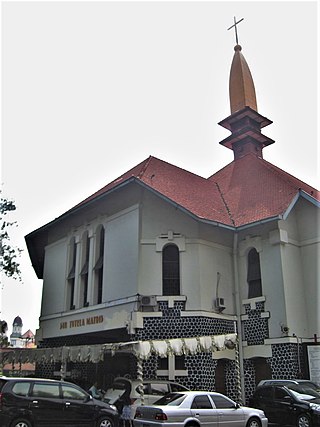
The Cathedral of the Virgin Mary, Queen of the Holy Rosary, also known as the Holy Rosary Cathedral or Randusari Cathedral, is a Roman Catholic cathedral and the seat of the Archdiocese of Semarang. Finished in 1927 at Randusari, Semarang, Indonesia, it became a parish church in 1930 and a cathedral in 1940, when Albertus Soegijapranata was made the first archbishop of Semarang.

The Protestant Christian Church in Bali is a Reformed denomination established in 1931 in Bali, Indonesia by the Christian and Missionary Alliance with help from the Dutch Reformed Church and the Church in East Java. The denomination adopted its current name on 21 April 1949. There are also churches located in Hamburg, Germany, Bern and Amsterdam.
The Luwu Indonesian Protestant Church is a member of the Protestant Church in Indonesia centered around the Luwu Regency.

St. Joseph's Church, also known as Gedangan Church, is a Catholic church in Semarang, Indonesia, the first such church in the city. Administratively, it is part of the St. Joseph's Parish in the Archdiocese of Semarang.
Mgr. Adrianus Djajasepoetra, SJ, was an Indonesian Roman Catholic prelate who served as the Vicar Apostolic of Jakarta and later its Archbishop (1953–1970). Before being a Vicar Apostolic, Mgr. Adrianus was a Rector of St. Ignatius College, Yogyakarta and the 4th Rector of Major Seminary, Kentungan, Yogyakarta (1948-1949).

Javanisation or Javanization is the process in which Javanese culture dominates, assimilates, or influences other cultures in general. The term "Javanise" means "to make or to become Javanese in form, idiom, style, or character". This domination could take place in various aspects; such as cultural, language, politics and social.

Bintaran is a village in Wirogunan, Mergangsan, Yogyakarta, Indonesia. The area is known for its Dutch-Javanese architecture. It was formerly a Catholic settlement.
